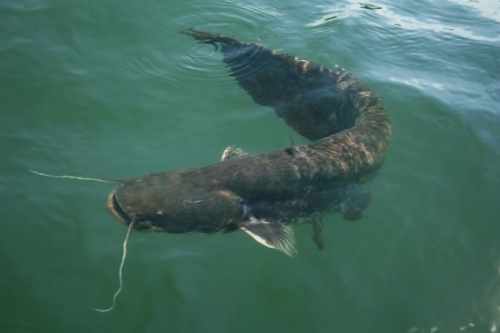We have to bear in mind that we can find catfish of a great variety of species. In the world, there are more than 3000 species of catfish, and each one of them has a specific characteristic. Obviously, not all of these fish will live in the same places since the features of each one will make them feel better in certain environments than in others.
Channel catfish may live in saltwater and freshwater, as well as brackish water; however, they are most commonly found in freshwater habitats. Numerous bodies of water, such as ponds, dams, and lakes, as well as places of flowing water, such as creeks, streams, and rivers, are home to channel catfish.
Blue catfish prefer the sandy bottoms of large and medium freshwater streams and ponds with strong currents and depths greater than 6 meters.
They choose to live near or in rock piles because they provide a safe refuge from the currents. In the springtime, they could reproduce and nest in locations with no or little current, such as reservoirs, sloughs, and backwaters. They seek out sheltered, somewhat isolated, and hidden spots like logs and under stones during these periods.
Flathead catfish can be found in slow-moving reservoirs, lakes, and rivers. Relatively shallow water is preferred by younger catfish of this type.
Flathead catfish that are bigger and older remain in deeper waters throughout the day and go to shallower water at night. They like to be close to or under shelters, such as brush heaps, logs, fallen trees, and river banks.
Table of Contents
Places Where Catfish Can Live or Stay
If you want to find catfish while fishing, some places will be better than others, depending on the type of catfish you are fishing.
River Holes
River-bottom holes are big-catfish magnets, despite being difficult to locate. These formations break the flux, allowing blues, channels, and flatheads to relax and feed.
In small streams, holes are formed under the sandbars, where the flux carries the bottom substrate. Catfish can be found in the holes of the great rivers just below the dams, around the outside curves, and near tributary mouths.
During the day, catfish remain in deeper places, but at night and on overcast days, they move to shallower locations to feed.
Outside River Bends
Rivers take the path with the least amount of resistance. The river reverses course when a solid bottom impedes the flow, generating a hard-bottomed outside bend with the current.
These curves are hotspots for trophy catfish, particularly flatheads, which like dark hollows. The river carves into the bank, causing undercuts that provide natural hiding places for huge hungry catfish.
Tributary Mouths
Pre-spawn and post-spawn catfish use tributary mouths as staging places. The location could have great potential all year if the mouth is reasonably deep or if the tributary stream joins a principal creek or river route on the bottom.
Most catfish are caught in tributaries with a warm inflow during the winter months. During the summer, cool streams are ideal. Catfish are drawn to the mouths of feeder rivers and streams by heavy rains that wash food into the primary water body.
Catfish attack prey by hiding behind flow breaks at the tributary’s confluence with the principal river or lake.
Riprap
Near causeways, bridges, and dams, engineers frequently put riprap, which are huge rocks along the shores to prevent erosion. Catfish prefer riprap since it attracts foraging animals while also providing shade, depth, and cover. Large channel cats, in particular, enjoy this environment.
Bottom Channels
There are conspicuous bottom channels in certain lakes and rivers, while others feature imperceptible ledges and drops. All of these structures are trophy catfish magnets that sonar could detect.
Migratory catfish use main channels as roads to get from one area of the water body to another. Migratory fish use little branches as alternative routes to get to shallow-water sites.
Trophy cats prefer to hang out near the channel’s deep water. You must seek them out near places such as adjacent humps, points, brush piles, cuts in the bank, etc. Outside bends of channel curves, stream intersections, and deep channel margins near dams are also popular with big catfish.
Deep Holes
Pond catfish can be found in the deepest water most times, usually close to a dam or reservoir if one exists. Just when levels of oxygen drop too low, catfish quit these places.
Deep tunnels are especially useful during the day when catfish seek refuge in the gloom.
Log Rafts
During rising tides, these mats of floating wood and garbage form in the backwaters of large rivers and streams. The flowing water presses against the seams of the still pool as current velocity and wave activity increase, forcing it to circulate like a gigantic vortex.
Logs pulled into this vortex generate rafts that can be up to a half-mile long. Baitfish and other fodder are attracted to the rafts, which attract catfish.

